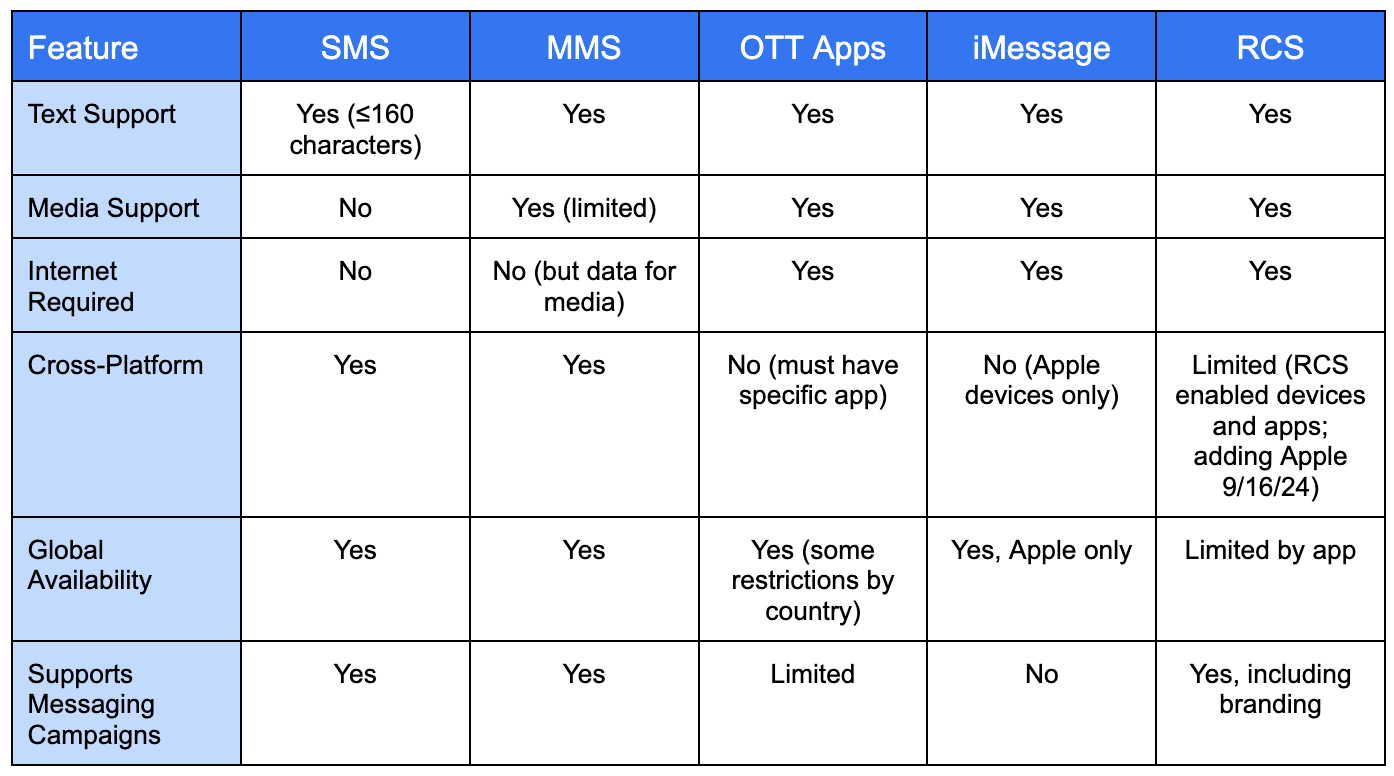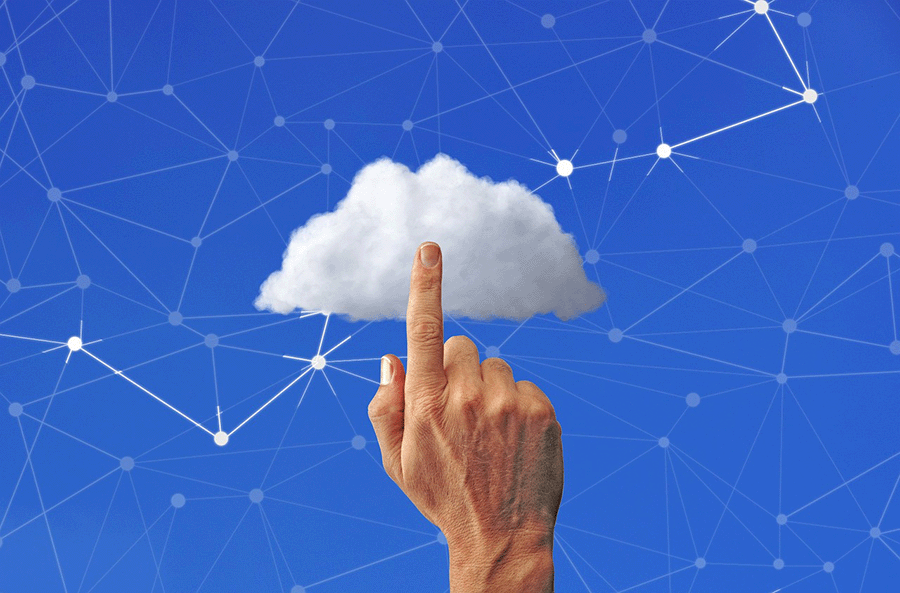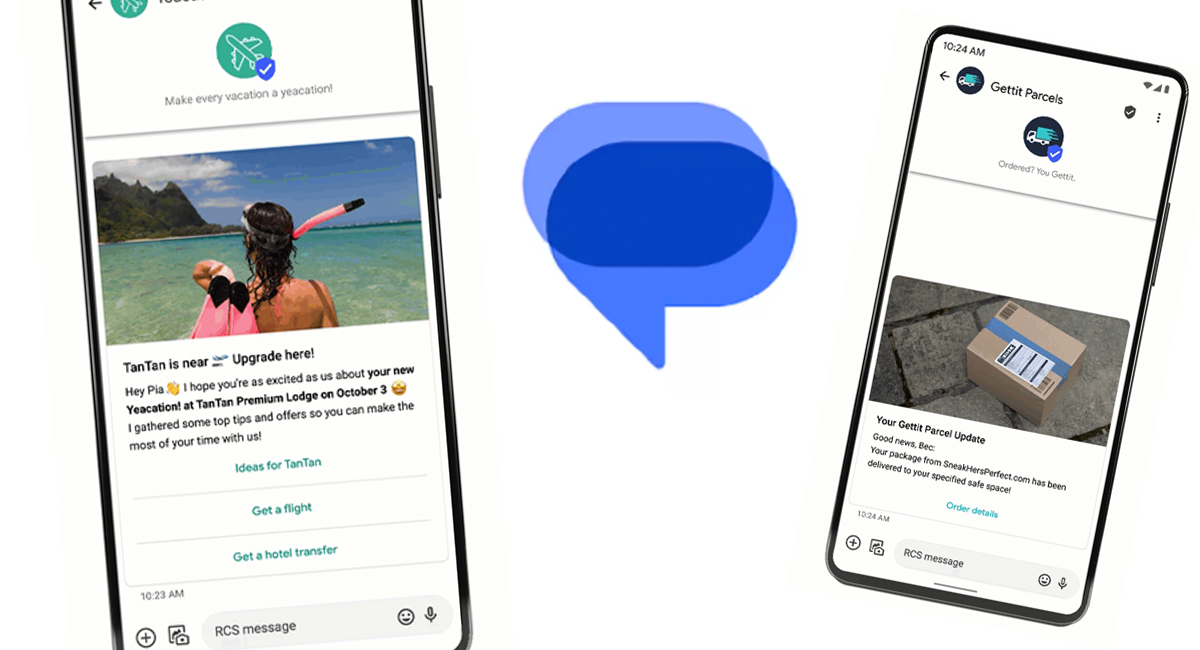Rich Communication Services (RCS) is Moving On Up
Virtually everyone is using messaging on their smartphone. Most people haven’t analyzed how their options might vary by the type of phone or app they’re using, their source of connectivity, or to whom they’re sending texts. There are numerous different types of messaging services, including SMS, MMS, iMessage, Rich Communications Services (RCS), and an assortment of over-the-top (OTT) options (messaging systems tied to an app, such as WhatsApp or Facebook Messenger).
So what’s the difference between each service, and why—or when—should you choose one over another? Most importantly for business users, how can you send a messaging campaign as part of your business or application?! The answer varies depending on who you’re messaging, what type of device they have, and what you need to communicate. Let’s look at each of them.
 Texting 101: Short Messaging Service (SMS) + Multimedia Messaging Service (MMS)
Texting 101: Short Messaging Service (SMS) + Multimedia Messaging Service (MMS)
SMS is the granddaddy of messaging, and a lot of people refer to all messaging as SMS. In reality it is, as the oldest version, the most basic messaging format. It’s limited to 160 characters, and it is just, well, text and links—no images, audio, video, or anything else.
On the positive side, SMS can be received by virtually anyone with a smartphone, regardless of phone type, anywhere in the world. Any smartphone can be the destination for short code, long code (10DLC), or toll-free messaging campaigns. Because it’s the oldest system, it may be the most basic but it’s also ubiquitous, regardless of device, location, or connection.
As the next generation of messaging, MMS is very similar to SMS in that virtually every smartphone can receive it, regardless of connectivity type, and it can be sent in any type of messaging campaign. The big upside is that you can send limitless characters (although lengthy texts are not best practice!), as well as images, animated GIFs, audio clips, and even short video files.
The downside is that MMS messaging campaigns are typically a little slower to send due to file size, and cost a bit more—a small price to pay if a picture is worth a thousand words to your business. Also, your carrier might limit file size (as does the recipient’s carrier).
Smartphones & Over The Top (OTT) Apps
OTT Apps are basically apps that include some kind of messaging service: Facebook Messenger, WhatsApp, Instagram Messages, Telegram, Signal, WeChat, and numerous others. These apps may exist primarily for the purpose of messaging, as in the case of WhatsApp, while others are secondary to the app’s primary function, as with Facebook and Instagram, and simply connect users.
Newer than more basic messaging services like SMS and MMS, no two apps are the same but they generally provide a wide array of media support, including text, images, videos, voice messages, file sharing, location sharing, and more; and, they typically allow large message/file sizes. Unlike SMS/MMS, they also require internet access but don’t necessarily need cellular service—Wi-Fi will also work.
The apps are available globally but some countries have restrictions, such as China. Usage tends to vary by demographics, as well. WhatsApp, for example, is more popular in Europe than America, and more commonly used by the younger crowd (but is also probably the largest stand-alone messaging app at 2B+ users).
While the capabilities may be dazzling, there is a downside for businesses hoping to reach people through these apps: Users must have the specific app installed (i.e., messages don’t run through your phone’s standard messaging app or between OTT apps such as WhatsApp to Telegram), and each user must have “connected” with or “friended” you first. So while you might not have to deal with the hassle of getting your messaging campaigns approved by the carriers, only targeted campaigns are possible. That said, it’s good to meet your customers where they are; companies have started using the bigger apps as a chat resource, plus the various interactive tools in WhatsApp Business.
Apple iMessage
iMessage is only available on Apple devices (iPhones, iPads, and Macs), and includes a host of features such as text, images, GIFs, videos, file sharing, apps, read receipts, typing indicators, and more with no size limits. Texts flow through Apple’s standard messaging app along with SMS/MMS, but only iMessages are encrypted and can contain the additional features. Texts from non-Apple devices appear green instead of blue, alerting users that a message is not an iMessage and isn’t encrypted. iMessages can be sent via Wi-Fi or cellular, but SMS/MMS messages in the same app require cellular service.
Americans love their Apples! Apples are the most popular smartphone in America with some 60% of Americans using one (compared to fewer than a quarter of users worldwide). However, it was designed with privacy in mind—there is not a mechanism for businesses to send an iMessage campaign directly from an Apple device to other Apple devices, or to include the additional features in a short-code, long-code, or toll-free campaign. If it were possible to send only to users with Apple devices, all recipients would also be able to see and reply to each other…awkward!
Rich Communications Services (RCS)
If your ear is to the ground at all, you’ve heard growing whispers about RCS, but what’s so special about it?
RCS is the Google/Android messaging protocol, similar to Apple iMessage and actually a little bit older (the default messaging app on Google/Android devices is Google Messages, also available via the web). Also like Apple, it includes an extensive array of enhanced features like read receipts, typing indicators, group chat, multimedia sharing, no size limitations (although again, this could be imposed by a carrier), and messages are encrypted.
Until recently, RCS messages could only be received by people with RCS-enabled phones and carriers, essentially most non-Apple users with a smartphone. If your standard messaging app doesn’t support it, you could always use Google Messages. An internet connection is required, either through mobile data or Wi-Fi, and it’s available in most countries but not all. As of today, Apple has rolled out iOS18, which includes native support for RCS.

Image courtesy of Google
RCS is just like iMessage, but here’s what else you get:
- It also works with your other mobile capabilities, allowing for QR codes, customizable buttons, etc., and could ultimately replace some of your apps (see example image).
- There are no carrier message surcharges as of this writing.
- Apple iOS now supports consumer, phone to phone (P2P) RCS in iOS 18. RCS is now virtually ubiquitous among text users. If RCS is unavailable between two users, the phone defaults to SMS/MMS.
- Best of all for our beloved business readers, business RCS (available in 2025) was designed to support commercial group interactions—i.e., messaging campaigns. Features include:
- Businesses must be verified by Google, but then they get a Verified Sender badge that indicates they’re trustworthy.
- Messages can be branded with your name, logo, and corporate colors, optimizing customer engagement.
- You can include those QR codes, buttons, and other capabilities in your messages, and possibly replace your own app.
Excited yet? We are! Commio and other messaging providers are looking for ways to support your access to RCS messaging campaigns. Details on pricing and other important considerations will be available in the coming months.
The Future of Messaging is Bright…and Extensive
Which messaging service makes the most sense for your communications needs? It depends on your target demographic (age, location, choice of app and/or device, etc.) and how complex your message is. RCS has some cool bells and whistles, but SMS and MMS will probably be more than adequate for the majority of business needs. Perhaps an OTT app makes sense. And while RCS looks to offer the most exciting array of opportunities for companies right now, it’s just the tip of the iceberg in the young and evolving messaging ecosystem. So think about the possibilities, stay tuned, and contact us with questions!

















